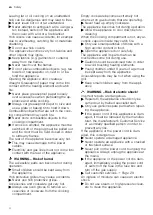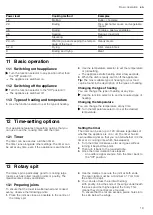
en
Environmental protection and saving energy
8
A build-up of heat on the electric hotplate may cause
damage.
▶
Ensure that the electric hotplate is never switched
on when the hob cover is on, e.g. by children play-
ing.
The heat of the electric hotplate can not be discharged
sufficiently and the electric hotplate may overheat.
▶
Never operate the electric hotplate without a pot.
▶
Do not use pots with an uneven base.
2.3 Electric hob
Follow the corresponding instructions when using the
appliance.
ATTENTION!
Food may spill.
▶
Remove spills immediately.
▶
Use deep pots for dishes with a lot of liquid.
▶
This prevents overflowing.
The base of the pot or pan may be damaged.
▶
Cookware that is used on the hotplate must be se-
curely in place.
▶
Only use pots and pans with an even base.
▶
Do not heat up empty pots or pans.
A build-up of heat on the electric hotplate may cause
damage.
▶
Ensure that the electric hotplate is never switched
on when the hob cover is on, e.g. by children play-
ing.
Salt water or hot pot bases may cause damage to the
electric hotplate.
▶
Keep the electric hotplate dry.
The heat of the electric hotplate can not be discharged
sufficiently and the electric hotplate may overheat.
▶
Never operate the electric hotplate without a pot.
▶
Do not use pots with an uneven base.
2.4 Drawer area
Follow the corresponding instructions when using the
drawer.
ATTENTION!
Do not place hot objects in the plinth drawer. The plinth
drawer may be damaged.
▶
Do not place hot objects in the plinth drawer.
Do not place oven accessories that exceed the height
of the drawer into the plinth drawer. Otherwise, this
may damage the appliance.
▶
Do not place oven accessories that exceed the
height of the drawer into the plinth drawer.
3 Environmental protection and saving energy
3.1 Disposing of packaging
The packaging materials are environmentally compat-
ible and can be recycled.
▶
Sort the individual components by type and dispose
of them separately.
3.2 Saving energy
If you follow these instructions, your appliance will use
less energy.
Only preheat the appliance if the recipe or the recom-
mended settings tell you to do so.
¡
Not preheating the appliance can reduce the en-
ergy used by up to 20%.
Use dark-coloured, black-coated or enamelled baking
tins.
¡
These types of baking tin absorb the heat particu-
larly well.
Open the appliance door as little as possible during
operation.
¡
This will maintain the temperature in the cooking
compartment and eliminate the need for the appli-
ance to reheat.
When baking multiple dishes, do so in succession or
in parallel.
¡
The cooking compartment is heated after baking
the first dish. This reduces the baking time for the
second cake.
If the cooking time is relatively long, you can switch
the appliance off 10 minutes before the cooking time
ends.
¡
There will be enough residual heat to finish cooking
the dish.
Remove any accessories that are not being used from
the cooking compartment.
¡
Accessories that are not being used do not need to
be heated.
Allow frozen food to defrost before cooking.
¡
This will save the energy that would otherwise be
required to defrost it.
Saving energy
If you follow these instructions, your appliance will use
less energy.
Choose a burner roughly the same size as your pan.
Centre the cookware on the hob.
Select the cooking zone to match the size of your
pan. Centre the cookware on the hob.
Use cookware whose base diameter is the same dia-
meter as the hotplate.
Tip:
Cookware manufacturers often give the upper
diameter of the saucepan. It is often larger than the
base diameter.
¡
Unsuitable cookware or incompletely covered cook-
ing zones consume a lot of energy.
Cover saucepans with suitable lids.
¡
Cooking without a lid consumes considerably more
energy.
Lift lids as infrequently as possible.
¡
When you lift the lid, a lot of energy escapes.
Use a glass lid.
¡
You can see into the pan through a glass lid
without having to lift it.
Use pots and pans with flat bases.
¡
Uneven bases increase energy consumption.









































